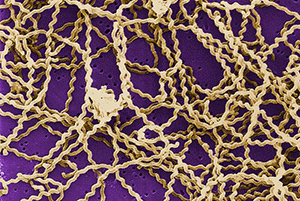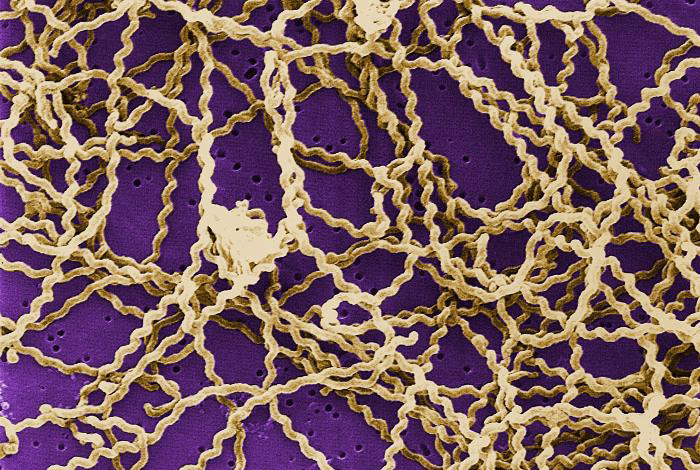How Spinning Coils Swim through Gloopy Liquids
Many microorganisms, including bacteria, spermatozoa, and parasitic worms, “swim” by means of tails or appendages that undulate or rotate helically. How this propulsion mechanism works in gel-like biological fluids has been unclear, with experiments seeming to give contradictory results. A report in Physical Review Letters offers a theoretical resolution, showing that in different circumstances the fluid’s properties can aid or hinder “helical swimmers.” The results could help in understanding the dispersal of some pathogens and the role of sperm mobility in fertilization.
Many biological fluids, such as mucus, are viscoelastic. As well as viscosity or “thickness,” they also have elasticity, meaning that when distorted they tend to return to their original shape. A viscoelastic fluid is harder to push through than a normal liquid like water, but it also gives a swimmer something to push against—so it’s not obvious whether swimming becomes harder or easier. Thomas Powers of Brown University in Providence, Rhode Island, and his colleagues say that the experimental record is mixed. Helically shaped bacteria swim faster in a viscoelastic solution of cellulose than in water, but both the nematode worm Caenorhabditis elegans and mammalian sperm make slower undulating progress in a viscoelastic fluid.
To make sense of these findings, Powers and his colleagues solved numerically the equations of motion describing the movements of rotating helical objects through a viscoelastic fluid. The equations embody a standard idealization that the fluid’s viscous and elastic properties do not change as it flows.
The behavior of a viscoelastic medium is governed by the Deborah number, De, which is the ratio of the timescale over which stresses in the fluid relax to the time scale of the distortion being applied to the fluid—in this case, the rotation period of the helix. When De is much less than one, the fluid relaxes faster than the applied stress distorts it, and it behaves like a normal liquid. When De is large, it acts more like an elastic solid.
The researchers found that the fastest swimming speeds occur for De around . In such conditions, “the rotation time is of the same magnitude as the elastic relaxation time,” says team member Saverio Spagnolie of the University of Wisconsin, Madison, so that perhaps the fluid can store and release energy at just the right rate to assist motion.
The team also found that when De is close to one, the geometry of the helix determines whether swimming is faster in a viscoelastic fluid or a normal liquid. The wake created by each turn may interact with subsequent turns of the coil, either hindering or helping the coil’s motion. It turns out that for a tightly wound coil this effect reduces the swimming speed, but if the coil is much more open, then the interaction may increase the speed. Spagnolie admits that a detailed understanding of these effects has yet to emerge.
There is some evidence that living systems can exploit these aspects of fluid behavior. The pathogen Helicobacter pylori, which is associated with some gastric ulcers, eases its movement by releasing enzymes that lower the elasticity of stomach mucus [1]. Better understanding of such phenomena may help deal with certain illnesses, says Spagnolie, and elucidate the cause of some reproductive difficulties related to sperm mobility.
Including the viscoelastic response of the fluid gives a “much more complete, though also much more complicated” understanding of bacterial propulsion, says Bruce Rodenborn of the University of Texas at Austin, who has studied how bacteria with helical flagellae swim. He thinks the findings should assist researchers aiming to make artificial “microswimmers” for medical and technological purposes. Bradley Nelson of the Swiss Federal Institute of Technology (ETH) in Zurich is working to make such devices for viscoelastic environments, such as the vitreous humor of the eye. “This work will help us to optimize our designs,” he says.
Spagnolie sees design implications already. “A rather small change in the helical radius and filament thickness may lead to a big change in the swimming speed,” he says.
–Philip Ball
Philip Ball is a freelance science writer in London. His latest book is How Life Works (Picador, 2024).
References
- J. P. Celli et al., “Helicobacter pylori Moves through Mucus by Reducing Mucin Viscoelasticity,” Proc. Natl. Acad. Sci. U.S.A. 106, 14321 (2009)





